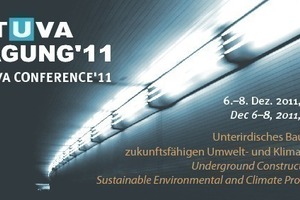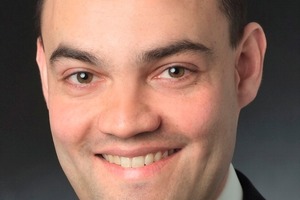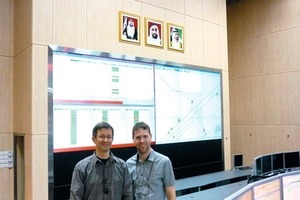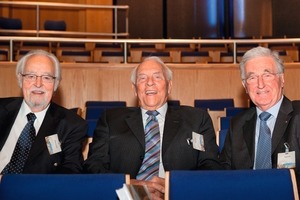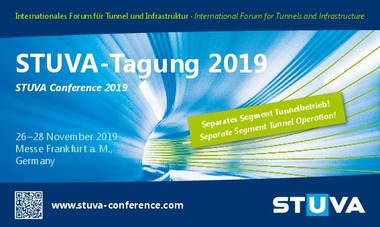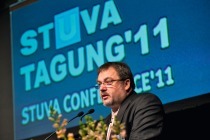STUVA News
STUVA Conference 2011
Correction regarding early Registration
In the last edition of STUVA News in tunnel 3/2011 (May issue) an error crept into the list of Conference fees. The reduced Conference charges apply in the case of registration prior to September 30, 2011 and not the end of November as is wrongly presented in the list (table 1).
The programme for the series of lectures within the framework of the STUVA Conference from December 6 to 8, 2011 at the Berlin Fairgrounds is available. Under the motto “Underground Construction for Sustainable Environment and Climate Protection” 42 speakers will present the expected 1,500 participants the basis for an international exchange of views in all fields of underground construction within the scope of a two-day series of lectures. The accompanying exhibition and the excursions on the third day round off the programme and afford additional opportunities to consolidate contacts and make new ones.
Environmental and climatic protection is gaining an ever increasing position of prominence within society. This applies all the more against the background of an ever growing world population. The related need for mobility can only be accomplished with the aid of underground transportation facilities on account of the limited amount of available space. Underground route alignments for the transportation of man and goods in an ideal manner culminate in mobility while at the same time saving resources and preserving environmental and climatic protection.
Nonetheless it has been revealed in Germany at least by recent projects that approval and planning processes can last a very long time with the outcome that there is a lack of acceptance on the part of the general public once a project is tackled. As a result we wish to examine this topic in the form of a keynote address.
Following the great amount of positive feedback relating to our jubilee celebrations for the first time within the scope of a “regular” STUVA Conference we intend providing talented up-and-comers with the chance to report on the fascination of tunnelling during the “Young Forum”.
With our Conference we provide you with an international platform for exchanging views on all sectors of underground construction. The accompanying exhibition and the excursions scheduled for Day 3 complete the programme and afford a further opportunity to consolidate existing contacts and establish new ones.
We invite you to attend interesting discussions at the STUVA Conference ’11 (Fig. 1) and look forward to welcoming you to the Berlin Fairgrounds. Take advantage of registering online by accessing www.stuva.de.
Programme of Lectures
Tuesday December 6, 2011
Opening
Prof. Martin Ziegler, Chairman of the STUVA Board, STUVA Inc., Cologne
Welcoming Address and Keynote Lecture
Effects of major Transportation Projects and the Eliminating of Terminal Stations on Berlin’s Transportation System
Dr. Friedrich Kunst, Department Manager for Transport; Burghard Horn, responsible for Transport Development Planning, Senate Administration, Berlin
Award of 2011 STUVA Prize
Keynote Paper
Onlooker, Opponent or Participant? – The Citizen’s Role in major Projects
Dr. Hans-Peter Meister, CEO IFOK GmbH, Bensheim
International Major Projects
Latest Developments in the Tunnel Design of the Fehmarnbelt Fixed Link
Steen Lykke, Project Director Tunnel, Fehmarn A/S; Susanne Kalmar Pedersen, Project Leader; Wim Janssen, Project Leader; Rambol-Arup-TEC Joint Venture, Virum, DK; Dr.-Ing. Karl Morgen, CEO, WTM Engineers GmbH, Hamburg
The Mont Cenis Base Tunnel:
Stage of Planning and Execution
Alain Chabert, Lyon Turin Ferroviare SAS, Chambéry, F; Lorenzo Brino, Lyon Turin Ferroviare SAS, Turin, I
The Brenner Base Tunnel:
From the Vision to Realisation
Prof. Konrad Bergmeister, Board of the Brenner Basistunnel Gesellschaft BBT SE, Innsbruck, A
Gotthard Base Tunnel:
Core Elements of a sustainable Transport Policy
Dr. Renzo Simoni, AlpTransit Gotthard AG, Lucerne, CH
Liefkenshoek Rail Link in Antwerp:
Shield Driving and Ground Freezing (Cross-Passages)
Ing. Johann Mignon, Wayss & Freytag Ingenieurbau AG, NL Benelux, Antwerp, B; Dipl.-Ing. Sascha Boxheimer, THV Loconouw/Wayss & Freytag Ingenieurbau AG, Sector Tunnelling, Kallo, B; Prof. Joachim Stahlmann, Institute for Foundation Engineering and Soil Mechanics, TU Brunswick
Top of Europe (Jungfraujoch):
Effects of unusual Boundary Conditions on Projecting and Construction Operation for the new Tour Tunnel
Dipl.-Ing. Rolf Gabriel, Department Manager Mining; Dipl.-Ing. Heinz Schmaus, Project Manager, IUB Ingenieurunternehmung AG, Berne, CH
New Ebensfeld-Erfurt Rail Route
The Reitersberg Tunnel as an Example of constructional Optimisations through applying a mobile Steel Bridge
Dipl.-Ing. Manfred Kicherer, CEO; Dipl.-Ing. Niklas Hirche, Project Manager, Alfred Kunze Untertagebau, Munich
Safety in Tunnelling
Accident at the Waidmarkt –
North-South Cologne Metro Line:
State of Affairs and Consequences, Salvaging and Inspection Pit, further Construction
Dipl.-Ing. Jörn Schwarze, Member of the Board; Dipl.-Ing. Rolf Pabst, authorised Officer, Project Manager Nord-Süd Stadtbahn, Kölner Verkehrsbetriebe AG, Cologne
Compensation Grouting as active Protection for existing Buildings during Tunnel Drives:
Planning Aspects and relevant Examples, Applications for Control and Analysis
Dr.-Ing. Heiko Neher; Dipl.-Ing. Frank Allgäuer, Ed. Züblin AG, Central Technology Tunnelling, Stuttgart
Special Demands on Logistics and Industrial Safety for Undertunnelling the Ems-Dollart for the Gas Pipeline betweenGermany and the Netherlands
Dipl.-Ing. Michael Harpf; Dr.-Ing. Klaus Rieker, Divisional Manager Wayss & Freytag Ingenieurbau AG, Tunnelling Division, Frankfurt/M; Dipl.-Ing. Ulf Spod, responsible for Shaft, Heading and Tunnel Construction, BG Bau, Frankfurt/M
Assessing the Safety of Road Tunnels - a holistic Approach:
Methods and Examples applicable to the Safety of the Building and the User
Prof. Markus Thewes; Dr.-Ing. Götz Vollmann, Chair for Tunnelling and Construction Management, Ruhr University Bochum; Dr.-Ing. Frank Heimbecher, Federal Highway Research Institute (BASt), Bergisch Gladbach
Overcoming geological Problem Zones using a TBM at the Gotthard Base Tunnel (Lucomagno/Piora/Tenelin)
Dipl.-Ing. Jens Classen, CSC Bauunternehmung AG, Lugano, CH
Legal Issues
Polluted Sites and harmful Changes to Soil in Underground Construction:
Steps and Measures to legally overcome the Conflict between Danger Prevention, Redevelopment and Fulfilling the Contract
Markus Vogelheim, Attorney, specialising in Construction and Architecture, CBH Rechtsanwälte, Cologne
Sustainable Contracts for Underground Construction Projects – 5 Theses for a Cooperation Model
Dr. Bastian Fuchs, TOPJUS Rechtsanwälte, Schroebenhausen, Armed Forces University Munich; Prof. Klaus Englert, TOPJUS Rechtsanwälte, Schrobenhausen, Humboldt University, Berlin
Young Forum
Consistent, computer-supported Application of the Observation Method after DIN 1054 for Process Adaptation in Tunnelling
Dr.-Ing. Felix Nagel, Zerna Ingenieure GmbH, Bochum
Development of innovative Concepts and economic Solutions during the Planning and Execution of a novel Inner Shell Structure for a Road Tunnel in Stockholm
Dipl.-Ing. Jörg Steppuhn, Dipl.-Ing. Andreas Rädle, HOCHTIEF Solutions AG, Frankfurt/M.
Comparative Examinations of compressible Elements for Application in squeezing Rock
Dipl.-Ing. Anna-Lena Wiese, Chair for Tunnelling and Construction Management, Ruhr University Bochum
Solving special logistical Difficulties for the construction works of the Pump Storage Plant Limberg II, Kaprun
Dipl.-Ing. Roland Schorn, Porr Tunnelbau GmbH, Vienna, A
Gala Evening
Wednesday December 7, 2011
Fire Protection
Current Developments for structural Fire Protection of Road Tunnels in Germany
Dipl.-Ing. Wolf-Dieter Friebel, Federal Ministry for Transport, Housing and Urban Development, Bonn; Dr.-Ing. Frank Heimbecher, Federal Highway Research Institute (BASt). Bergisch Gladbach
State of the Art fixed Fire Fighting Systems for Road an Rail Tunnels:
From Fire Tests to Implementation
Dipl.-Ing. Max Lakkonen; Dipl.-Ing. Till Bremke, FOGTEC Fire Protection, Cologne
Results of Fire Tests to assess the Efficiency of Water Mist Fire Fighting Systems in Road Tunnels
Dr.-Ing. Roland Leucker, CEO, STUVA Inc., Cologne; Dipl.-Ing. Stefan Kratzmeir, IFAB Ingenieure für angewandte Brandtschutzforschung GmbH, Rostock
Risk Analysis of Fire Incidents in trackbound Public Transit Tunnels
Dr.-Ing. Jörg Schreyer, CEO, STUVAtec GmbH, Cologne
Tunnel Ventilation / Tunnel Operation
Fire Ventilation Concepts for European, underground Light Rail Systems, taking the Example of Geneva (CEVA)
Dr. Andreas Busslinger, Project Manager; Dr. Mattia Ferrazzini, Project Manager; Dr. Peter Reinke, Project Manager, HBI Haerter AG, Berne, CH
Gotthard Base Tunnel:
Operating Ventilation for normal and stand-by Mode,
Smoke and Fire Gas Removal, Production of Overpressure
Frank Pochop, Head of Development and Structural Works; Simon Peggs, Senior Manager Structural Works Furnishing, AlpTransit Gotthard AG, Lucerne, CH
Engineering-technical Testing and Monitoring of Structures for Tunnels and Stations on urban Metro Systems
Prof. Rolf Katzenbach; Dipl.-Ing. Steffen Leppla, Institute for Geotechnics, TU Darmstadt; Dr.-Ing. Ulrich Osthöver; Dipl.-Ing. Volker Pulverich, Verkehrsgesellschaft Frankfurt am Main mbH
Dust in Rail Tunnels:
Causes, Risks and Counter-Measures
Ing. Robert Lassy, Wiener Linien GmbH & Co KG, Vienna, A; Dr.-Ing. Bernd Hagenah; Dr. Johannes Rodler, Gruner GmbH, Vienna/A
Mechanised Tunnelling
Technical and economic Advantages through Optimising technical and operative Interfaces for Shield Drives taking the Example of the major Project in Sochi
Dr.-Ing. E.h. Martin Herrenknecht, Chairman of the Board, Herrenknecht AG, Schwanau
High Rates of Advance and long Service Life through selecting Construction Parameters optimally geared to the geological Conditions for Earth Pressure Balance (EPB) Tunnelling Machines
Martin Eckert, CEO, Robbins GmbH, Göppingen; Shinichi Konda, Chief Engineer, The Robbins Company, Solon, Ohio, USA
Clogging during EPB Drives:
Influences, Classification and new Methods of Manipulation
Dipl.-Ing. Martin Feinendegen; Prof. Martin Ziegler. Geotechnical Engineering, TWTH Aachen; Dr. Markus Weh, Marti Tunnelbau AG, Berne, CH; M. Sc. Giovanni Spagoli, Fugro Consult GmbH, Pfungstadt
The European X-Ray Laser XFEL:
Findings during the Execution of Construction taking particular Account of Shield Start-ups and Exits as well as Towing Procedures
Dr.-Ing. Christof Gipperich, HOCHTIEF Solutions AG, Civil Engineering and Tunnelling, Essen; Dipl.-Ing. Gerhard Menke, ARGE Tunnel XFEL, HOCHTIEF Solutions AG, Schenefeld; Dipl.-Ing. Bernd Stüber, Bilfinger Berger Ingenieurbau GmbH, Tunnelling Division, Munich
Shield Drives in Mexico City:
Technical Challenges of Driving Technology and Segment Design
Dr.-Ing. Ulrich Maidl; Dipl.-Ing. Marc Comulada, Senior Engineer, Maidl Tunnelconsultants GmbH & Co. KG, Duisburg; Ing. Adrián Lombardo, Director, Constructora Mexicana de Infrastructura Subterránea, S.A. (COMISSA); Mexico City, MEX
Cement-free Mortar for annular Gap Grouting during
mechanised Tunnel Driving
Prof. Matthias Pulsfort, Institute of Geotechnics, Bergische Universität Wuppertal; Dr.-Ing. Christian Thienert, STUVA Inc., Cologne
Limmern Pump Storage Plant –
Access Tunnel with 8 m Diameter and 24 % Gradient
Dipl.-Ing. Peter Kirchhofer, Department Head, Gruner AG, Basle, CH; Dipl.-Ing. Philippe Müller, Head of Hydraulics Division, Axpo AG, Baden, CH; Dipl.-Ing. Manfred Voerckel, Aker Wirth GmbH, Erkelenz
North/South Line Amsterdam – Tunnelling close to piled Foundations:
TBM Design, Settlement Performance, Compensation Grouting, injectable Coupling System for the Tunnel Rings
Ir. Frank J. Kaalberg, Design Manager; Ir. W.H. Nikolaas C. van Empel, Project Leader Tunnel Design, Adviesbureau Noord/Zuidlijn/Witteveen+Bos, Amsterdam, NL; Ir. Paul P.M.K. Janssen, Contract Manager; Ir. Joost F.W. Joustra, Project Leader Tunnelling Process, Dienst Noord/Zuidlijn, Amsterdam, NL
Tunnel Redevelopment / Tunnel Improvement
Report on State of Affairs for Redeveloping Rail Tunnels-
Results of Deliberations by the STUVA Working Group
Dipl.-Ing. Stefan Simon, DB Projektbau GmbH, Frankfurt/M
Total Renovation of the Lucerne City Ring:
An initial Balance of innovative Solutions for operational and safety Installations, Carriageway Drainage, Ventilation System as well as Trasport Logistics
Dipl.-Ing. Matthias Neidhart, Senior Manager Cityring, Department Head; Dipl.-Ing. Benoit Stempfel, Deputy Senior Manager, Lombardi AG Beratende Ingenieure, Lucerne, CH
Findings with Redeveloping old Railway Tunnels while in Operation taking the Pforzheim Tunnel as an Example –
Variants, Cost Effectiveness, Total Risks
Dipl.-Ing. Manfred Thömmes, Project Manager Pforzheim Tunnel, DB Projektbau GmbH, Frankfurt/M; Dr.-Ing. Claus Erichsen, CEO; Dr.-Ing. Jens Gattermann, authorised Officer; Dr.-Ing. Martin Wittke, CEO, WBI GmbH, Aachen
Underground Construction in Berlin
Redevelopment and Improving Fire Protection in old Metro Tunnels and Stations in Berlin:
Structural Measures and Costs
Dipl.-Ing. Hans-Christian Kaiser, Divisional Head Metro; Dipl.-Ing. Uwe Kutscher, Department Head Engineering Structures, Berliner Verkehrsbetriebe AöR (BVG), Berlin
Geotechnical and geological Challenges during the further Construction of the U5 Metro Line in Berlin-Mitte
Dipl.-Ing. Georg Breitsprecher, Department Manager; Dipl.-Ing. Helmut Haß, CEO, CDM Consult GmbH, Berlin; Dipl.-Geol. Jörg Seegers, Project Manager U5, Berlin Verkehrsbetriebe AöR (BVG), Berlin
Aspects of Planning the U5 Metro Line, Berlin – Closing the Gap between Alexanderplatz and the Brandenburg Gate
Dipl.-Ing. Paul Erdmann, Amberg Engineering AG, Regensdorf-Watt, CH; Dipl.-Ing. Torsten Brenner, Berliner Verkehrsbetriebe AöR (BVG), Berlin; Dipl.-Ing. Josef Schmeiser, ISP Ziviltechniker GmbH. Vienna, A; Dipl.-Ing. Michael Weizenegger, SSF Ingenieure GmbH, Munich
Closing Remarks
Prof. Martin Ziegler, Chairman of the Board STUVA Inc.,
Cologne
Excursions
The participants at our Conference are cordially invited to take part in one of the excursions, which embrace a variety of themes. The “Metro Cabrio Tour“ taking the form of a special trip, which is scheduled for Wednesday evening (Dec. 7) – outside the actual excursion programme, represents a particular highlight. The excursions on Dec. 8 are offered parallel to one another. As a result it is only possible to participate in one such trip.
Through the Berlin Underworld with the Metro Cabrio
Anyone desirous of getting to know Berlin “from below” is advised to take part in this special tour. Undoubtedly it is Berlin’s most unusual round trip. With a Metro Cabrio you travel in an open carriage at roughly 35 km/h on a genuine voyage of discovery through Berlin’s Metro tunnels. Specially geared to the STUVA Conference participants it will be accompanied by a competent expert, who will provide information on the redevelopment measures taken to upgrade the 100 year old Berlin Metro network and the architecture of the stations. Tour conducted only in German.
U5 new Construction from Alexanderplatz to the Brandenburg Gate
The continuation of the roughly 2.2 km long route section of the U5 between the already existing Metro stations “Alexanderplatz” and “Brandenburger Tor” is being tackled by shield driving and embraces 3 stations “Berliner Rathaus” with track switching facility, “Museumsinsel” and the “Unter den Linden” hub. This project is marked by technical challenges starting with the link with the existing “Brandenburger Tor” Station right up to the link with the existing U5 at the “Rotes Rathaus”. The new route is crossed by the existing U6 at the Friedrichstraße, towards which end the setting up of the “Unter den Linden” hub has to be carried out by closing the Friedrichstraße for just a year and interrupting services on the U6. Undercrossing the Spree and the Spree Canal as well as the production of the “Museumsinsel” Station will be accomplished with the aid of ground freezing. Essentially we wanted to show you the Line U5 construction sites during the course of our excursion programme. Unfortunately this is not possible on account of unforeseen delays in starting construction. Nonetheless, we can still offer you an attractive programme in conjunction with this highly sophisticated construction scheme. We invite you to visit the “Brandenburger Tor” as target station for the shield drive including the archaeological site at the future Rotes Rathaus Metro station. Followed by a detailed discussion on the U5’s special features with local experts in the Rotes Rathaus. Tour conducted only in German.
Ostkreuz – The most important Traffic Hub in the Berlin Transit System is being revamped
The Ostkreuz Station is numbered among the busiest transfer hubs in the Berlin transit network. Experts forecast a frequency of 123,000 passengers (including transfers) per day for the year 2015. The station will continue services while it is converted at a cost of some 411 m. euros up until 2016. Altogether 50 different construction stages will be necessary until a modern transit station is completed, which will then provide optimal linkage for a number of transportation networks (regional traffic, S-Bahn, tram and bus).First of all details of the complex construction scheme will be given in the Ostkreuz info centre then a site inspection will provide an overview of the construction programme. Tour conducted only in German.
A “smoky” Thing – the BVG’s Fire Service Training Facility at the Jungfernheide Metro Station
The fire service training facility at the Jungfernheide Metro station has been operational since July 2003 and is unique in Germany. The 350 m long facility in the non-operational tunnel running towards Tegel is the masterpiece of the BVG’s track construction trainees. There they laid 350 tonnes of ballast, 540 sleepers, 220 m of electrified track and built points for a decommissioned 4-carriage train. In addition the section of tunnel is equipped with all necessary operational installations (emergency and info display columns, route telephones, water supply etc.).
This facility nowadays serves to provide training for staff on how to conduct themselves in the event of fire as well as for third-party and self-evacuation drills. This section of tunnel is separated from the operational Metro services by a gate. As a result it is possible to fill the tunnel with smoke by artificial means and undertake drills under extremely realistic conditions. Consequently drills are carried out here on a regular basis in conjunction with the fire service, police and emergency organisations (DRK – German Red Cross, Technisches Hilfswerk – Federal Agency for Technical Relief) in ordered to be well prepared for a case of emergency. The inspection programme comprises an introductory lecture, a film featuring a drill and an on-the-spot demonstration. Tour conducted only in German.
Driving Simulators – virtual Metro Journeys
Constructing a Metro system is one thing, trips by Metro another. Would you like to get to know the work of a Metro train driver? If so, give it a try. Not in a tunnel but on the BVG’s Metro simulator. – In other words, virtually but extremely like a journey in the real world of the Metro. Normally learner drivers experience important parts of their basic training on the driving simulator and the related signal-box simulator. Driving instructors and other participants can follow their colleagues’ journeys exactly in the simulator cab and establish just where and when errors are made. Particularly critical situations and failures can be simulated as well. Everything seems most realistic as the actual conditions can be reproduced to a remarkable extent. The tour consists of an introductory lecture, visiting the driving simulator and the signal-box simulator as well as a hands-on journey in the driving simulator. Tour conducted only in German
City Tour featuring Buildings of Interest
Berlin is a city with many faces, a city of rapid change, in which individual phases of urban development have left clear traces. Geared to the participants of the STUVA Conference this tour concentrates on buildings relating to transport, which were created prior to and after 1990 in conjunction with the centre of Berlin receiving a new facelift as well as Metro facilities and inner urban motorway tunnels. We invite you to take part in an excursion to places worth seeing and buildings from Berlin’s architectural past – accompanied by a highly competent guide. You will be able to see the usual sights as well as being introduced to some out of the ordinary landmarks of the past. Tour conducted only in German.
BBI – the Capital’s new Airport Berlin-Brandenburg International
The concept of the new Berlin-Brandenburg International (BBI) entails a modern airport with short distances, with the terminal located between the two parallel take-off and landing runways. The airport has already been completed in its rough state (scheduled to be opened in 2012) representing a unique hub and designed as an airport of the new generation: favourably priced, functional, cosmopolitan and with modern architecture. The capital region will be able to provide an airport with the best traffic connections in the form of the BBI: with its own motorway link, a main-line station immediately below the terminal and connected to the Berlin S-Bahn network. The 305 m long, 6-track ICE station with its 3 km long tunnel system in particular represents an outstanding building achievement. A rail facility was produced directly beneath the main terminal set 9 m deep in the groundwater by cut-and-cover. The tour first and foremost is concerned with the underground rail installations as well as a number of constructional highlights of the BBI airport. Tour conducted in German and English.
Pure Innovation – constructing modern Rail Vehicles
Berlin is the international centre for Bombardier Transportation’s administration. Bombardier’s largest engineering and production plant in Germany is to be found in the immediate vicinity in Hennigsdorf. In addition to the design and manufacture of local projects, from here other locations in Germany and throughout the world as well as joint projects with other companies are lent support. Bombardier designs, builds and tests electric and diesel-powered vehicles and railway carriages at its Hennigsdorf location. These include trains for the Berlin Metro, electric regional trains for the DB AG and high-speed trains for Germany and Scandinavia. Significant innovations from the last one hundred years have evolved at the plant under various corporate names. The recently presented Zefiro 380 high-speed train continues this tradition. Within the scope of the tour apart from an overview of the facility, pre-fabrication of engines and final assembly for the various track-bound vehicles will be shown. Tour conducted in German and English.
New STUVA Staff Member Dr.-Ing. Christian Thienert
Since May 2011 Dr.-Ing. Christian Thienert (Fig. 3) has been lending his active support to STUVA in the field of tunnelling and construction technology. His particular niche will be expanding contacts between STUVA and its members and pinpointing joint aspects of research. Towards this end the focus will be on issues, which are hard to verify under site conditions and as a result require closer deliberations on a real or semi-technical scale. For this purpose at STUVA’s headquarters in Cologne there are facilities available, which are spread over a total hall area of 2,000 m².
Furthermore Dr. Thienert will also be involved on the sector of public research into tunnelling. One aim here is to come up with innovative possibilities for underground infrastructure so that the acceptance of corresponding construction measures is enhanced among the general public.
Within the scope of his activities so far Dr. Thienert was intensively involved in industrial research projects in the field of mechanised tunnelling. In this connection he concentrated on among other things the transference of supporting pressure while driving with fluid-supported face and for annular gap grouting, He mainly used his experience to link up engineering disciplines such as geotechnics and construction material technology with the relevant engineering technology His dissertation just published by the Shaker-Verlag, Aachen, deals with the topic of cement-free annular gap mortars.
We shall gladly advise you on your research ideas. You can reach Dr. Thienert at STUVA headquarters.
SOLIT2 – Fire Tests and International Workshop in Spain
Within the framework of the “Safety of Life in Tunnels 2” (SOLIT2) research project an international workshop was held in Asturia, Spain captioned “Fire Suppression Systems in Tunnels” on June 22 and 23, 2011. The workshop took place at the end of a 4-week long test phase, during which in May and June 2011 more than 30 major fire tests in a 600 m long test tunnel at San Pedro de Anes were carried out. In this connection half the tests were pool fires with loads of up to 100 MW as well as solid matter fires with complete lorry loads (fire load 100 MW, consisting of wooden pallets). The test tunnel possesses a characteristic cross-section for road tunnels and is equipped with a ventilator system for longitudinal and semi-cross ventilation.
The 2-day workshop in northern Spain provided participants with an initial insight into the preliminary results of the project and an overview of the current stage of development of automatic fire fighting systems as well as the currently valid international guidelines. Further papers examined major topics dealt with in the project such as numerical simulation, life cycle costs and compensation potential.
The highlight of the workshop for those taking part was the chance to carry out large-scale fire tests within the scope of the SOLIT2 test programme in the immediate vicinity. Thus in the presence of the participants a pool fire with 60 MW load as well as a solid matter fire with a complete lorry load of wooden pallets (fire load 100 MW) was carried out. As fire tests in this magnitude can very seldom be undertaken, even for leading experts the workshop turned out to be a rare opportunity to experience such critical fires close-up.
The effect of the water mist system was something the participants could follow for themselves. In spite of the major fire load caused by the pallets it was possible to approach as much as 2 to 3 m from the fire after activating the water mist system. The unanimous opinion was expressed especially on the part of fire service personnel that it is thanks to the water mist system that it is possible to get so close to the fire thus enabling the emergency services to tackle the conflagration effectively.
In addition to the positive subjective impressions the measured values also confirmed the good impact of the water mist system: the release of heat is reduced, the temperatures around the fire sink and visibility nonetheless remains acceptable.
The tests have shown that a fire suppression system is also capable of mastering fires, which the prevailing ventilation is unable to cope with (Fig. 4).
In the German “SOLIT2” research project in particular the interaction between water mist fire suppression systems and other safety facilities in tunnels is examined. The research project has the aim of identifying compensation potentials through the application of fire fighting systems and developing practice-oriented solutions within the framework of a holistic tunnel safety concept. Furthermore numerical computation models are being further developed to reliably predict the fire course and the extinguishing effect during the application of water mist systems by means of CFD (Computational Fluid Dynamics). The fire tests serve on the one hand to optimise the water mist system and on the other provide the measurement data needed to develop and validate the software.
Apart from STUVA the partners in the project are BUNG, Fogtec, Ruhr University Bochum and TÜV Süd. It is sponsored by the Federal Ministry for Economics and Technology (duration: 2009 till 2011). The latest details about the project are obtainable from STUVA or by accessing www.solit.info.
UpSafety Research Project: Training multi-disciplinary Emergency Forces – Closing Conference
On June 30, 2011 the closing conference for the UpSafety research project took place at Terneuzen, Netherlands, at which the most important results were presented to the international experts present as well as the general public.
The project’s aim was to optimise evacuation and civil protection measures in underground facilities. Towards this end since October 2009 during the 2-year duration of the project training programmes were developed successfully for all the emergency services taking part particularly for application in road tunnels, Metro facilities as well as subterranean car parks.
On account of its many years of experience in the field of safety in underground facilities STUVA took charge of the “Metro Facilities” sector. In addition to the STUVA 5 further partners from the Netherlands, Belgium and Spain were involved in the research project: Province Zeeland/NL as project coordinator, Falk AVD/NL, Amberg Infrastructuras SA/E, Westerscheldetunnel/NL and the Gent Fire Service/B.
Essentially in the event of an accident concentrated intervention of all the emergency forces involved – the fire service, paramedics, the operator’s control centre, service staff, police and representatives of the authorities – is of decisive importance. This requirement applies all the more given the even more difficult conditions prevailing in underground facilities. A multi-disciplinary approach has to be implemented in order to ensure that all those involved fulfil their tasks should the worst happen.
As a result in the UpSafety project so-called ETE programmes (Education-Training-Exercise) have been devised for all services involved in emergencies for applications in road tunnels, Metro stations and subterranean car parks. The exercise concept, which is set up in 3 stages, is based on the 3 elements education, training and practical exercises. Special software has been developed within the scope of the theoretical training, which serves as a virtual reality tool. This application supports a realistic simulation of multi-disciplinary operations in the above-mentioned underground facilities. The learning effect previously only attained in practical exercises can in this way be achieved at least partially in the theoretical part of the training. As a consequence the costs for complex practical exercises can be reduced.
On the day prior to the closing conference the concepts that were developed were demonstrated to the experts present in practical and theoretical exercises. Mastering a real car fire in a test facility in the form of a specially set up parking level at Gent/B was shown as a practical application. The test facility’s dimensions (30.0 x 29.0 x 2.7 m) and its equipping with powerful ventilation units and passive fire protection measures permitted a realistic simulation of an actual scenario, without having to take potential damage to the structure into account.
The fire affecting the vehicle (Fig. 5) spread to a neighbouring one within a few minutes and led to extremely strong smoke development. As an additional difficulty 2 victims with restricted mobility as a result of fire smoke trapped in the subterranean garage also had to be rescued. Owing to the intensity of the smoke visibility was extremely limited and the fire service personnel had to rely on thermal imaging cameras.
Under the direction of a multi-disciplinary Belgian team the exercise scenario was mastered without any problems. The outcome was that the victims could be evacuated quickly and the burning car extinguished effectively (Fig. 6).
Following the practical exercise a demonstration of the theoretical part of the multi-disciplinary training took part at the Gent fire brigade’s headquarters. Fire incidents in a road tunnel, a Metro station and a parking facility as accident scenarios had to be tackled. Teams from the Netherlands, Belgium and Romania, in each case comprising emergency services from the fire brigade, ambulance service, police as well as facility operators were deployed. The various scenarios were visualised (Fig. 7) for those involved and the experts present with the aid of the virtual reality tool that had been devised.
The experts taking part in the closing conference unanimously evaluated the developed training scenarios, supported by the extended virtual reality application, as a good back-up to the exercises practised so far.
Further details on the UpSafety project are available from STUVA or by accessing www.upsafety.eu
STUVA Young Engineer’s Prize – Travel Report
On the occasion of the jubilee conference marking STUVA’s 50th anniversary in June 2010 bearing the caption “Past meets Future” for the first time STUVA presented the STUVA Young Engineer’s Prize. Dr. Jan-Niklas Franzius from the Ed. Züblin AG was awarded the prize for his contribution “Geothermal Application of TBM-driven Tunnels” after emerging as winner of the competition in the “Young Forum”. The final choice took place on the basis of an assessment by those attending the jubilee event, which took the contents of the paper, the nature of its illustration and the manner of presentation into consideration. At the time Dr. Franzius was able to convince the audience in all these points. In the meantime he has been able to receive his prize, a trip for 2 persons to Dubai.
Dr. Franzius undertook the journey together with his colleague Dipl.-Ing. Wolf Friedemann at the beginning of April. Both are involved at Züblin in the in-house research project “Geothermics in TBM-driven Tunnels”.
They paid a visit to the “Roads and Transport Authority” (RTA) in particular the hi-tech bus control centre in Dubai (Fig. 8). In Dubai the RTA operates one of the world’s most advanced public transportation systems with the recently opened Metro (still partially being built) and around 1,900 buses.
The hi-tech buses enable the members of staff in the control centre to monitor the vehicles in real time (e.g. video monitoring in the buses, traffic management, 3D-GIS city plan presentation) and information for passengers in the vehicles and at bus stops. The STUVA was supported by the INIT AG on the spot in terms of organisation. The INIT AG is a member of STUVA and a leading supplier worldwide in the field of telematic and electronic payment systems for buses and railways.
Furthermore the visitors informed themselves about the 15.6 km long part-section of the “Strategic Tunnel Enhancement Programme” (STEP) in Abu Dhabi, which is currently under construction. The project was initiated by the Abu Dhabi Sewerage Services Company (ADSSC) in 2006 and relates to an altogether 40 km long underground sewage channel with 6.10 m diameter. The project is devised to cope with the increasing demands on an effective sewer system brought about by the immense growth experienced by the region.
Professor Ernst-Ulrich Hiersche: 80 Years old
In June 2011 Prof. Ernst-Ulrich Hiersche turned 80.
Prof. Hiersche has been closely associated with the STUVA since he became an honorary board member in 1977. With his wide spectrum of knowledge in the field of highways and transportation, he has never ceased propagating STUVA’s interests and helped shape its growth. From 1979 till 1981 and 1985 till 1997 he was STUVA’s deputy chairman. Since stepping down from the STUVA board he has become an honorary member and is always a welcome guest at STUVA conferences. Fig. 9 shows him in the Tonhalle Düsseldorf on the occasion of the STUVA jubilee together with other former members of the board Dr.-Ing. Eduard Hamm and Assessor Wilhelm Brand, who are now also honorary members.
The STUVA/STUVAtec team would like to wish Prof. Hiersche all the best on his anniversary, good health and a prosperous future.


